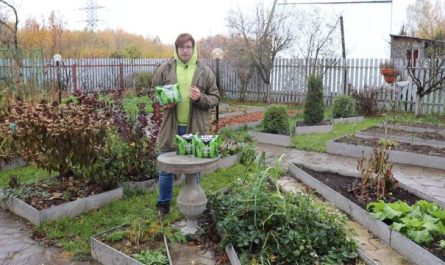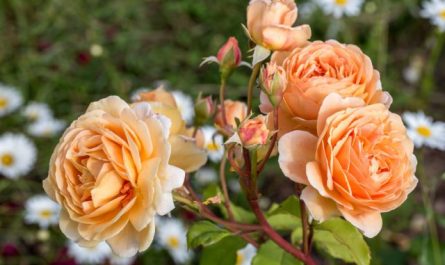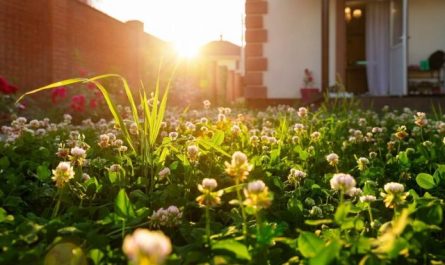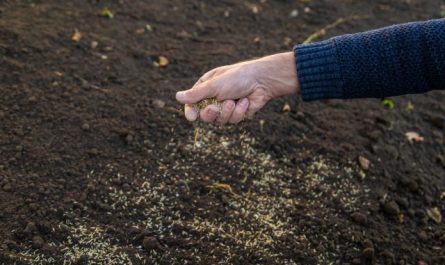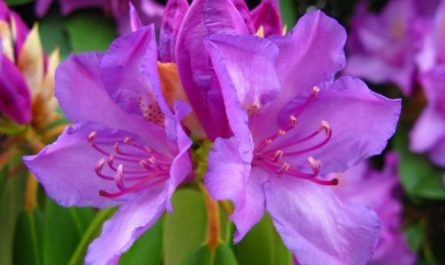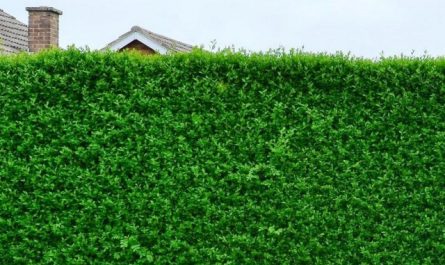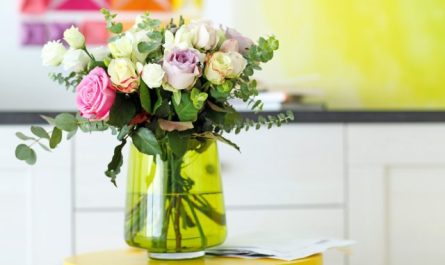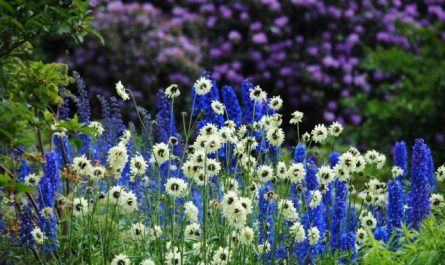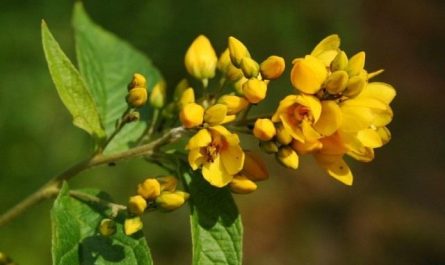There are many interesting tools for revealing the beauty of plants in garden design. One of the most striking ways to highlight the advantages of your favorite and bright stars is mono-flower beds. Created from just one type of plant, they are actually a declaration of love for your favorite garden crops. From legendary rose gardens and iridariums to more modest flower beds or separate islands, mono-flower beds always highlight the beauty of the chosen plant. Simple means are used for this.

Using Mono-Colored Plants in Garden Design
The term “mono-flower beds” has become so popular today that its meaning and definition have even begun to be somewhat distorted. From rare solutions for only individual gardens, mono-flower beds have become a favorite technique of designers and amateur gardeners. This is a truly special type of flower beds and garden compositions that invariably becomes the center of everyone’s attention.
Monoflora, or monoclumb – a decorative composition created to reveal the beauty of one species (or genus) of plants. A monoflower garden can be a garden of only species and varieties of the selected plant or an ensemble with a small addition of other crops to highlight its beauty. But, in essence, a monoflower garden is still a garden of one species of plants. These are ceremonial or dominant types of compositions that should be regarded and used as eye-catching points and the main decoration of the site.
The main goal of creating mono-flower beds is to fully reveal the beauty of the selected plant. There is no other way to so vividly emphasize all its advantages (as well as its features in general). This is a chance to create an ensemble in which you can admire the selected culture to your heart’s content.
The essence of a monoflower bed – the elevation of one single plant to the absolute – is the main secret of its creation. Monoflower beds should be dedicated to the most beloved garden crops – those without which they cannot imagine the design of the plot, that is, those dearest to the heart of the gardener.
This is the best way to maintain, create and replenish a collection of your favorite plants, allowing you to collect species and varieties in one place and actually create your own mini-garden dedicated to one garden crop.
This type of flowerbed is considered one of the simplest in structure and organization, but at the same time — difficult to care for. In fact, it simplifies the cultivation of capricious plants as much as possible — a separate composition is allocated for them, with ideal conditions, which is easy to care for. Of course, the disadvantages of the plant can be fully manifested, but the effect of a ceremonial presentation of decorative qualities always compensates for this “minus” with interest. As well as the ability to calculate, provide for any little things that can affect the development of the plant and the quality of its flowering.
Mono-flower beds are an element of the design of a predominantly regular garden. Previously, it was believed that it was impossible to introduce them into the design of a natural style, but in recent years, professional designers have presented interesting projects that refute this rule. Of course, mono-flower beds cannot be used to imitate wild plantings. But in a romantic, modern, country style of landscape design, you can experiment with them quite freely.
Today, there is some confusion with the use of the term “monoflower garden”, apparently due to translation difficulties. Sometimes, monochromatic compositions are considered monoflower gardens – made with a selection of plants in one color. But since we are talking about the concept of only a color palette and a fundamentally different principle of creating ensembles, an absolutely different method of constructing a composition, monochrome (single-color) flower beds cannot be considered monoflower gardens.

Advantages and disadvantages of mono-flower beds
It is worth creating a mono-flower garden in your garden for at least the following reasons:
- full disclosure of the plant’s virtues;
- enhancing the effect of abundant color, the beauty of the structure of inflorescences and individual flowers, or the color of leaves;
- increase in preferred collection;
- revealing the diversity and richness of the varietal palette of the selected crop;
- the opportunity to collect a collection of unique varieties;
- a more thorough study of the plant’s characteristics;
- variety of reproduction experiments;
- simplification of garden maintenance by “isolat[ing]” the most capricious species;
- ease of watering, fertilizing, pruning;
- the ability to select optimal lighting and adjust the soil composition to create conditions close to ideal;
- easier preparation for winter;
- the ability to expand the mono-flower bed to any area, if desired;
- an easy process of culling unproductive or disappointing varieties, diseased or poorly overwintered plants and replacing them with new specimens.
But monoclumps, of course, also have their downsides, which not every gardener is ready to accept:
- the decorative period of the composition is limited by the flowering or vegetation period of the plant (with the exception of evergreen species);
- increased manifestation of plant deficiencies;
- the need for more careful care;
- increased risk of infection for less resistant plants.

Types of monoflowers
Mono-flower beds are most often associated with small flower beds-islands on the lawn or a neat border. But their settlement is much more diverse. In terms of the size of the composition, mono-flower beds are divided into three categories:
- mini flower beds with an area of less than 2 square meters;
- small flower beds up to 6 square meters;
- medium-sized mono-flower beds with an area of up to 15 square meters;
- large and giant mono-compositions (usually they are created for favorite shrubs).
Most often, when choosing the size, they are guided by the place that can be allocated for a mono-flower bed. But it is always worth remembering the proportion, the relationship with the surrounding landscape and the need to maximally reveal the beauty of the plant itself. The area of the flower bed should not lead to the fact that the plants on it get lost and look nondescript or, on the contrary, too bulky and inappropriate.
Mono-flower beds can be very different in terms of the type of flower beds themselves. Single (free-standing) mono-flower beds – the most popular option. They are placed on lawns or clearings of ground cover with a comprehensive view. Such mono-flower beds can be strict (circle, square, semicircle, rectangle, rhombus) or with blurred contours.
But mono-flower beds can also be laid out as a separate border or a two-sided border, a group of plants around a large tree or adjacent to some border, a small architectural object, a path, in fact breaking it up as a full-fledged flower bed and even as a camouflaging group.
If a flowerbed is laid out over a large area, it can be presented as a series of mini-flowerbeds or divided into walking areas by paths. Large, single-color flowerbeds are always designed as a complex of individual simple “modules”, compensating for some dullness with the help of form.
Rose gardens, lilacs and other mono-flower beds can even be placed in a separate area, separating them into a special garden “room with a secret”. The variety of such a flower bed in shape and size is not limited by anything.
In terms of content, mono-flower beds are divided into three categories:
- homogeneous (simple) mono-flower beds created from one variety or species of plants;
- “flat” mono-flower beds with plants of the same height, but with a variety of colors;
- relief compositions of a strict type (with strict observance of the ranking of plants from tall in the center or in the background to low in the foreground or at the edges), as well as landscape type (without strict alternation and pattern);
The most important thing in classifying monoflower beds is determining their type. Monoflower beds can be “clean”, with decorative mulch or bare soil and not involving the use of plants to create a background. And there are also supplemented monoflower beds – with planting along the front edge, as a border or to fill the soil of partners, not drawing attention to themselves, but shading the beauty of the main star plants.
Most often, additional plants are used for mono-flower beds made of shrubs, but for herbaceous plants it is preferable to choose the right mulch and variety so that the composition does not look sloppy.

Features of creating mono-flower beds
The choice of location for a mono-flower bed is a key factor for success. They can be laid out where there is space for this, but not in the “backyards”. A mono-flower bed is a ceremonial composition. It is placed where it will immediately catch the eye. Only places that are visible from the entrance to the area or from the path are suitable for it, that is, areas that can attract the eyes of guests.
From a practical point of view, there are no simpler compositions than mono-flower beds. In essence, their creation comes down to selecting varieties and species of plants and placing them in the allotted area. Of course, there is much to take care of – from selecting conditions to the process of planting and caring for plants. But the process itself is much simpler than creating any mixed flower bed.
The selection of conditions for a mono-flower bed is always carried out according to the preferences and characteristics of the selected plant. Lighting, soil characteristics, fertilization and correction of soil reaction – everything should be selected strictly individually. Even the timing of pre-planting work with soil is best determined by the type of plant. But there are also procedures that any mono-flower bed will definitely need:
- deep digging;
- selection of weed rhizomes, stones, and other debris.
The number of plants in a mono-flower bed is determined by its area and the specific plants used. There is a strict limitation only for shrubs: a mono-flower bed can only be considered a composition of at least 5 plants. For herbaceous crops, and any mono-flower beds in general, it is better to make a calculation by dividing the area allocated for mono-flower beds by the recommended distance for planting a specific species.
The choice of planting material for mono-flower beds is very important. If you use the strategy of sowing in the ground, using seedlings or one-year-old shrub saplings, it is worth considering how much time the plants will need to reach the peak of decorativeness.
For mono-flower beds, it is usually recommended to use large, adult plants and divisions that are capable of blooming the following year. The choice of shrub seedlings is especially important, because the wait for the first flowers for them can stretch out to more than five years, or it can be only a year or two.
In the process of creating mono-color beds, everything comes down to simple procedures:
- The surface of the future mono-flower bed is leveled.
- Plants are laid out on the flowerbed, observing the recommended distances when planting and placing the plants in accordance with the mono-flowerbed plan.
- Individual holes are dug for the plants.
- The seedlings are carefully dug in, gradually filling the planting holes with substrate and maintaining the recommended depth.
- If you plan to plant background plants, they are placed after the main ones.
- The planting process is completed with abundant watering.
- The surface of the mono-flower bed is mulched. If the plants need protection from direct sunlight, additional screens are installed.
For mono-flower beds that do not provide for planting additional plants, it is necessary to select mulch and take care of the design of the front edge. Today, not only bark and compost, sawdust or decorative gravel are available for mulching. Original multi-colored coverings made of artificial stone and multi-colored sand, as well as the range of other types of decorative mulch, are amazing.
The border is created based on the solutions and style already used in the garden. Neat steel tape, clinker brick, mini-wattle, stonework and other materials should be checked for compatibility with the selected plant: the texture and color of the border do not always successfully emphasize the beauty of the main plants. When choosing a border, it is worth remembering whether there will be an opportunity to expand the flowerbed if desired.

Plants for mono-flower beds
Mono-flower beds are most often named after the plant they are dedicated to. True stars are chosen for mono-flower beds. Of course, theoretically, mono-flower beds can be created from any plant – perennials, annuals, and shrubs – but not all of them will successfully cope with their task.
Flowerbeds of annuals, including mono-flower beds, are simply planted with seedlings of favorite plants. For them, choose species with the longest and most lush flowering or with the status of a cut flower. Gazania, marigolds, celosia, petunias, snapdragons – the choice is made to your taste.
Among herbaceous perennials, the best flowering crops are chosen for monoflower beds. The most popular options include:
- iridariums – mono-flower beds of irises;
- primularia – compositions of primroses;
- floxarium – a mono-flower garden of phloxes;
- lilinaria – mono-flower beds of lilies;
- peonies – mono-flower beds of peonies.
Mono-flower beds are also created for collections of rudbeckia, lavender, daylilies, chrysanthemums, asters, ornamental grasses, etc.
Flower beds made of bulbous or tuberous plants always have a special status. Mono-flower beds made of tulips, gladioli, daffodils, alliums (ornamental onions), dahlias or more exotic bulbous plants look elegant and are the best seasonal subspecies of mono-flower beds. But they are decorative only during the flowering period and most often such a mono-flower bed requires the addition of annuals to maintain the decorative effect throughout the gardening season.
Mono-flower beds of beautifully flowering shrubs have also become legendary – mono-flower beds of rhododendrons, hydrangeas, lilacs, and, of course, roses. After all, every rose garden remains a mono-flower bed – according to the features of the arrangement and selection of plants, as well as their presentation.
The process of selecting plants to create a mono-flower bed depends on the decorative task. For homogeneous simple mono-flower beds from just one type of plant, it is enough to stock up on the required number of seedlings. If complex compositions are made, then the choice is made based on several characteristics and parameters of the plants.

The main criteria for selecting species and varieties:
- Flowering periods, the ability to extend the flowering and decorative period of the entire composition for as long a period as possible.
- Plant height is selected depending on the desired relief of the composition and its design.
- Texture, lines and sizes of leaves. If the choice of varieties and species of plants allows, it is worth following the general principles of composing compositions, observing the contrast between neighboring plants and trying to emphasize the beauty of each individual culture. Strict and landscape, with a dense crown and an openwork effect, small or large leaves, different shades of green or a variety of color effects – plants can add more depth to a mono-flower bed.
- Color range – even for mono-colored beds it can be very different. Contrasting color combinations, harmonious palette, one tone or color, watercolor effects – there is plenty to choose from.
When selecting varieties, it is worth considering the general properties and “compatibility”, the play of not only colors, but also aromas, growth rates, and the degree of endurance. If there are “untested” varieties or varieties with unknown characteristics, it is worth planting them along the edge of mono-flower beds so that the risk of replacement is associated with less injury to the rest of the plants.
If you decide to emphasize mono-flower beds with a line of plants along the front edge or ground covers, then the choice is made primarily based on the same requirements for growing conditions. Unpretentious and quickly filling the soil, but not aggressive partner crops are the favorites. Periwinkles, geraniums, bugleweed, deadnettle, saxifrage, loosestrife are just a few candidates from which to choose.
At the forefront, crops are planted that are ideal partners for the chosen star (for example, hostas and ferns for rhododendrons, lavender and wormwood for roses), capable of shading the beauty of the main stars with their soft line and not drawing too much attention.

